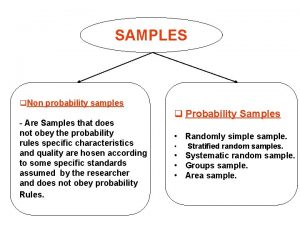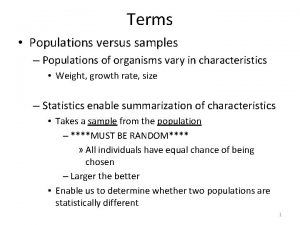Understanding Populations Samples THE PENNSYLVANIA STATE UNIVERSITY COLLEGE





































- Slides: 37

Understanding Populations & Samples THE PENNSYLVANIA STATE UNIVERSITY COLLEGE OF NURSING 200 W

What is a Sample? • Defines the selected group of people or elements from which data are collected for a study.

What are concepts related to sampling? • Selecting a group of people, events, behaviors, or other elements with which to conduct a study • The sampling plan identifies the sampling method and defines the selection process • Members of the sample can be called the subjects or participants.

What is considered the population? • A particular group of individuals or elements who are the focus of the research • Elements are the individual units of the population or sample

What are the components of a population? Target Population • An entire set of individuals or elements who meet the sampling criteria Accessible Population • The portion of the target population to which the researcher has reasonable access

What is generalization? • Extending the findings from the sample under study to the larger population • The extent is influenced by the quality of the study and consistency of the study’s findings.

Check Your Understanding: Question Sampling in research may be defined as: A. Insurance that each person has a chance of being included in the study. B. Establishment of criteria for eligibility to participate in a study. C. Identification of the population in which the researcher is interested. D. Selection of a subset of a population to represent the whole population.

Check Your Understanding: Answer • ANSWER: D • Sampling involves selecting a group of people, events, behaviors, or other elements with which to conduct a study.

What are inclusion criteria? • Characteristics that the subject or element must possess to be part of the target population • Examples: ◦ Between the ages of 18 and 45 ◦ Ability to speak English ◦ Admitted for gallbladder surgery ◦ Diagnosed with diabetes within past month

What are exclusion criteria? • Characteristics that can cause a person or element to be excluded from the target population • Examples: ◦ Diagnosis of mental illness ◦ Less than 18 years of age ◦ Diagnosis of cognitive dysfunction ◦ Unable to read or speak English

What are two ways to define sampling criteria? Homogeneous • As similar as possible so that extraneous variables can be controlled Heterogeneous • Broad, diverse range used when a narrow focus is not wanted

What is an inappropriate generalization? • Samples cannot be generalized beyond their sampling criteria. This means that results cannot be inferred to populations that differ from the sample. • This may lead to inappropriate generalizations: ◦ Because of language or reading ability ◦ To other types of illnesses or injuries

Check Your Understanding: Question Subjects who participate in a study of patients with inflammatory bowel disease are described as the: A. Accessible population. B. Element. C. Sample. D. Target population.

Check Your Understanding: Answer ANSWER: C A sample is that group of people who are representing the entire population and participating in the study. Samples are expected to represent an entire population. The accessible population is that portion of the entire population that the researcher can actually use. An element is an individual unit of a study population. The target population is the entire set of individuals who meet the sampling criteria.

What is a sampling error? • Difference between the population mean and the mean of the sample • Random variation is: ◦ The expected difference in values that occurs when different subjects from the sample are examined ◦ Difference is random because some values will be higher and others lower than the average population values

What types of sampling errors can occur? • Systematic variation or bias ◦ Consequence of selecting subjects whose measurement values differ in some specific way from those of the population ◦ These values do not vary randomly around the population mean.

What is the difference between random and systematic variations? • Random variation is the expected difference in values that occurs when different subjects from same sample are examined • Systematic variation or systematic bias is the consequence of selecting subjects whose measurement values differ in some way from those of the population

What is attrition and retention in reference to research samples? • Sample attrition is the withdrawal or loss of subjects from a study ◦ Attrition rate = number of subjects withdrawing ÷ number of study subjects × 100 • Sample retention is the number of subjects who remain in and complete a study

Sampling Frame and Sampling Plan • Sampling frame: A listing of every member of the population, using the sampling criteria to define membership in the population • Subjects are selected from the sampling frame • Sampling plan: Outlines strategies used to obtain a sample for a study ◦ Probability sampling plans ◦ Nonprobability sampling plans

What is random sampling? • Increases the representativeness of the sample based on the target population • A control group is used in studies with random sampling • A comparison group is not randomly determined

Types of Probability Sampling Simple random sampling Stratified random sampling Cluster sampling Systematic sampling

What determines sample size in quantitative research? • Effect size • Type of quantitative study conducted • Number of variables • Measurement sensitivity • Data analysis techniques

What is effect size? • The effect is the presence of the phenomenon being studied. • The effect size is the extent to which the null hypothesis is false. • When the effect size is large (large variation between groups), only a small sample is needed. • Increasing the sample size increases the effect size.

How do you determine the number of variables? • As the number of variables increases, the sample size may increase. • The inclusion of multiple dependent variables also increases the sample size needed.

What is measurement sensitivity? • The reliability and validity of the tool used to measure the variable of interest • As the variance in the instrument scores increases, the sample size needed to obtain significance increases.

Check Your Understanding: Question The population from which the researcher selects the actual study sample is referred to as the: A. Accessible population. B. Scientific population. C. Target population. D. Theoretical population.

Check Your Understanding: Answer ANSWER: A The accessible population is the portion of the target population to which the researcher has reasonable access. The sample is obtained from the accessible population. Scientific population is not a correct term. The target population is the entire set of individuals who meet the sampling criteria. The theoretical population is the same as the target population, which is the entire set of individuals who meet the sampling criteria.

What is involved in critically appraising a study sample? • Identifying the following: ◦ Elements ◦ Accessible population ◦ Target population • Evaluating the: ◦ Appropriateness of generalizations or conclusions in quantitative studies based on the population of interest, sample used, and findings

Appraising the Sample • Identify the sample criteria. • Judge the appropriateness of the sampling criteria. • Identify the sampling method.

What is nonprobability sampling? • Used in qualitative research and includes the following types of samples: ◦ Purposive sampling ◦ Network or snowball sampling ◦ Theoretical sampling

Purposive Sampling • Also called judgmental or selective sampling • Efforts are made to include typical or atypical subjects. • Sampling is based on the researcher’s judgment.

Network or Snowball Sampling • Also called snowball sampling • Takes advantage of social networks to get the sample • One person in the sample asks another to join the sample, and so on.

Theoretical Sampling • Used in grounded theory research • Data are gathered from any individual or group that can provide relevant data for theory generation. • The sample is saturated when the data collection is complete based on the researchers’ expectations. • Diversity in the sample is encouraged.

How is sample size determined in qualitative research? Scope of the study Nature of the topic Quality of the data Study design

How is the sample adequacy determined in qualitative studies? • Are the sampling inclusion and exclusion criteria appropriate? • Is the sampling plan adequate to address the purpose of the study? • Is the sample size adequate? • What are the refusal and mortality rates?

How is the sample adequacy determined in qualitative studies? • Are sample characteristics and quality described? • Is there saturation of the data? • Is the setting defined?

Questions? Comments? THE END!
 Section 19-1 review understanding populations
Section 19-1 review understanding populations Chapter 8 understanding populations
Chapter 8 understanding populations Hospital university of pennsylvania
Hospital university of pennsylvania California university of pennsylvania global online
California university of pennsylvania global online Pa state plane coordinate system
Pa state plane coordinate system Pennsylvania state animal response team
Pennsylvania state animal response team Dr john yelenic
Dr john yelenic 沈榮麟
沈榮麟 Understanding solid state physics
Understanding solid state physics Lake erie coastal plain
Lake erie coastal plain Rachel carson was born in 1907 in springdale pennsylvania
Rachel carson was born in 1907 in springdale pennsylvania Pennsylvania
Pennsylvania Xoom energy pennsylvania
Xoom energy pennsylvania Pennsylvania new hire reporting
Pennsylvania new hire reporting New york, new jersey, pennsylvania, and delaware
New york, new jersey, pennsylvania, and delaware Sandata electronic visit verification
Sandata electronic visit verification My uncle from pittsburgh pennsylvania
My uncle from pittsburgh pennsylvania Bharp
Bharp Amerihealth caritas pennsylvania community healthchoices
Amerihealth caritas pennsylvania community healthchoices Pennsylvania ecosystems
Pennsylvania ecosystems Pennsylvania dutch council
Pennsylvania dutch council Modern real estate practice in pennsylvania
Modern real estate practice in pennsylvania Servient tenement
Servient tenement Pa forest products association
Pa forest products association Pennsylvania association of school business officials
Pennsylvania association of school business officials Mayflower compact significance
Mayflower compact significance The southernmost part of pennsylvania was once called
The southernmost part of pennsylvania was once called Summer key for pennsylvania trees
Summer key for pennsylvania trees Nfce pennsylvania
Nfce pennsylvania Pennsylvania
Pennsylvania Liquor liability insurance pennsylvania
Liquor liability insurance pennsylvania Modern real estate practice in pennsylvania
Modern real estate practice in pennsylvania Stuttering center of western pennsylvania
Stuttering center of western pennsylvania Commonwealth of pennsylvania department of public welfare
Commonwealth of pennsylvania department of public welfare A harvest of death gettysburg pennsylvania
A harvest of death gettysburg pennsylvania Homestead pennsylvania tourism
Homestead pennsylvania tourism Pa space grant
Pa space grant Free radon test kit pennsylvania
Free radon test kit pennsylvania




























































